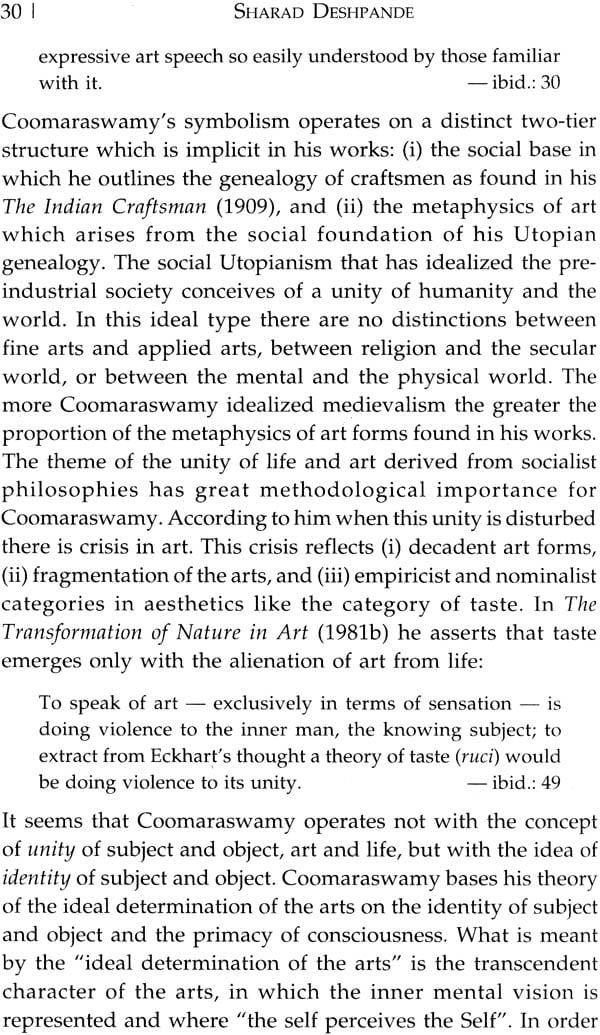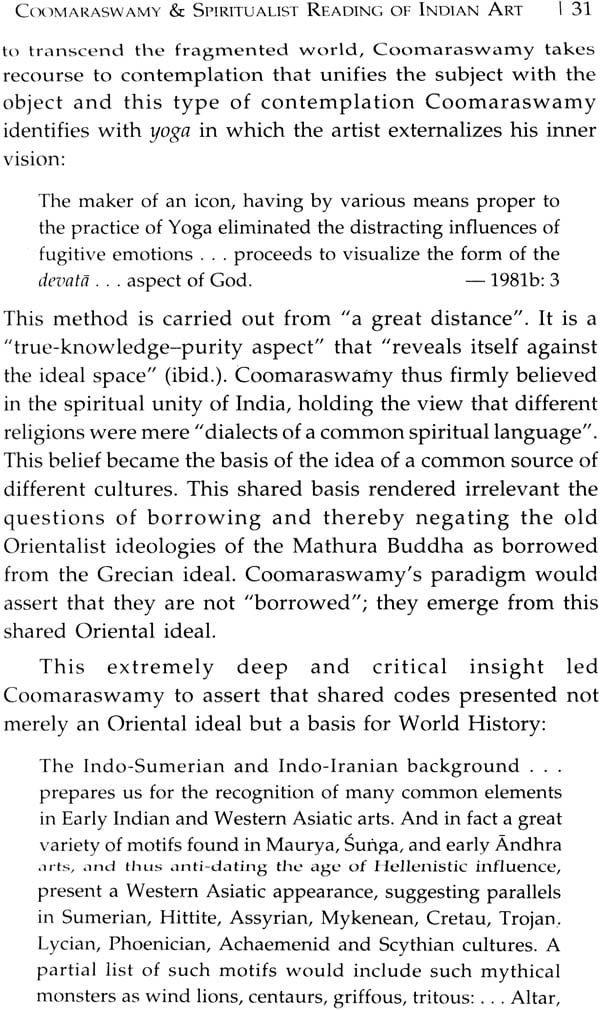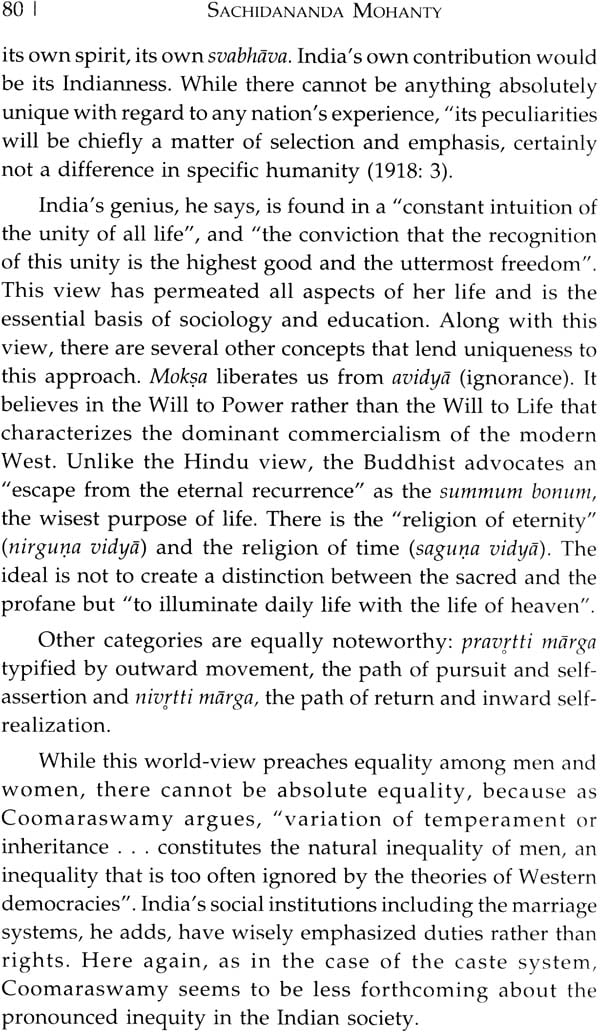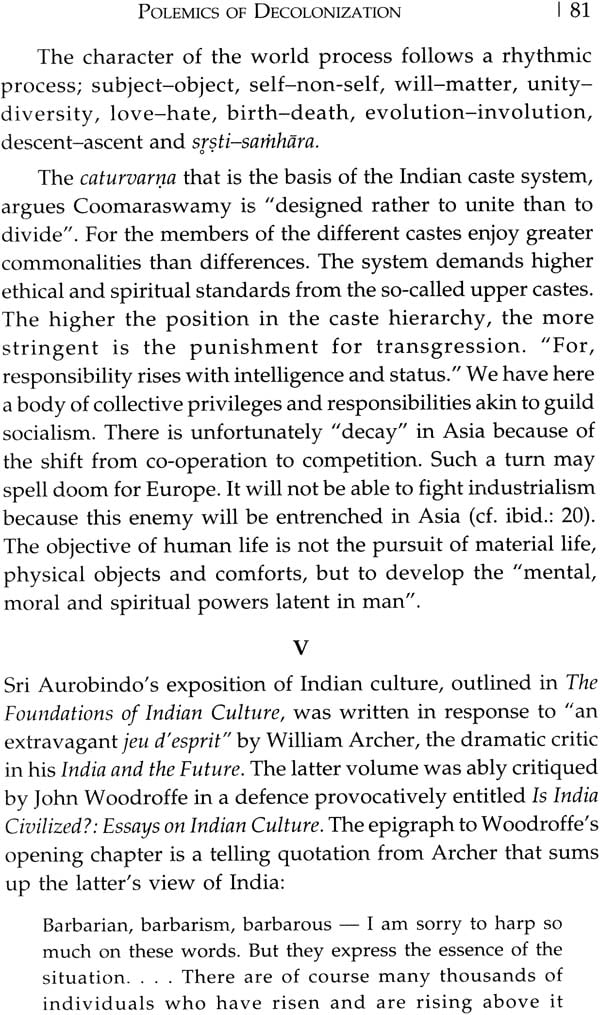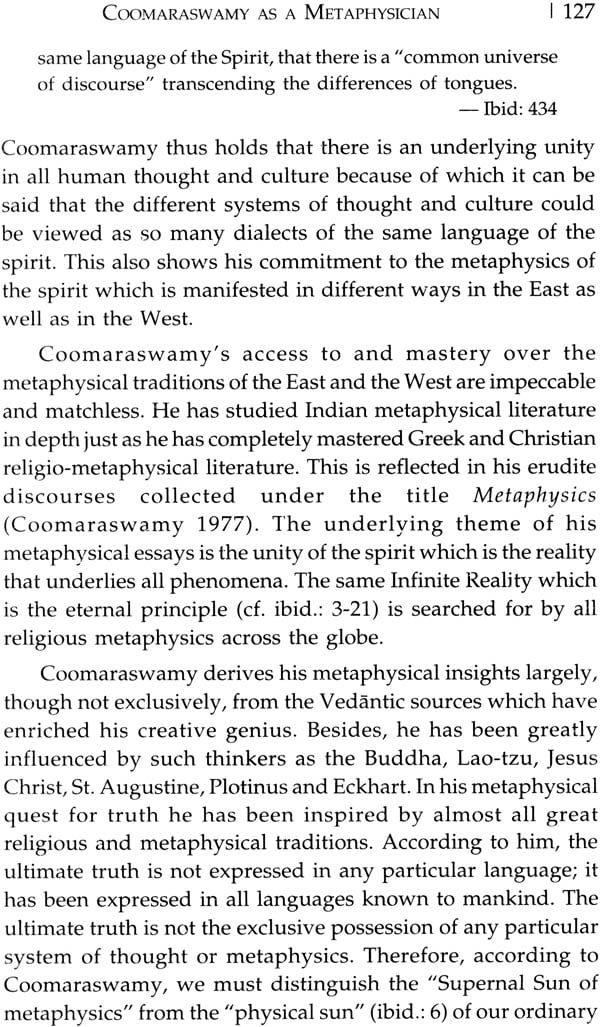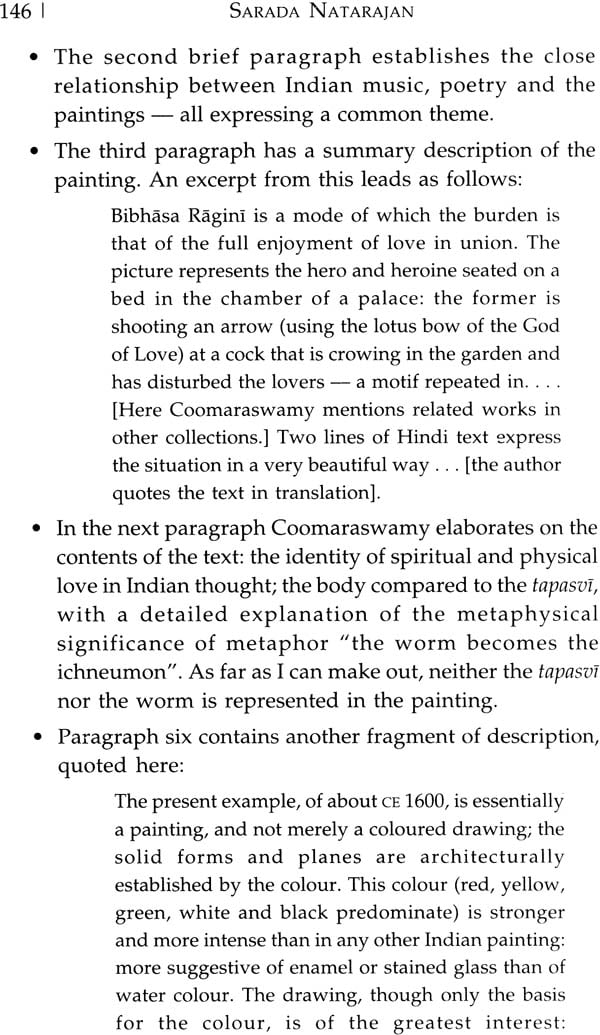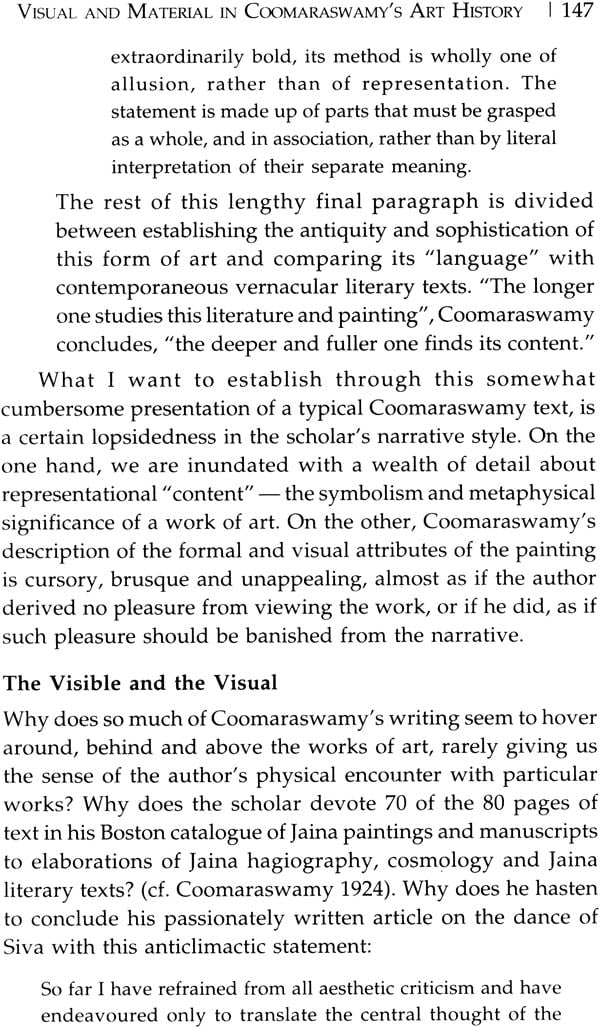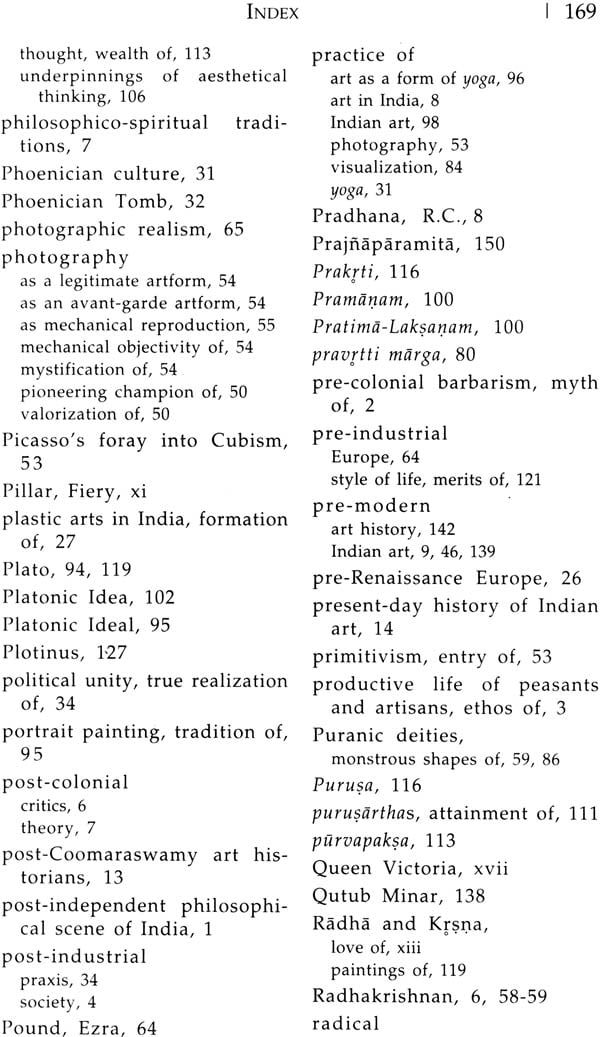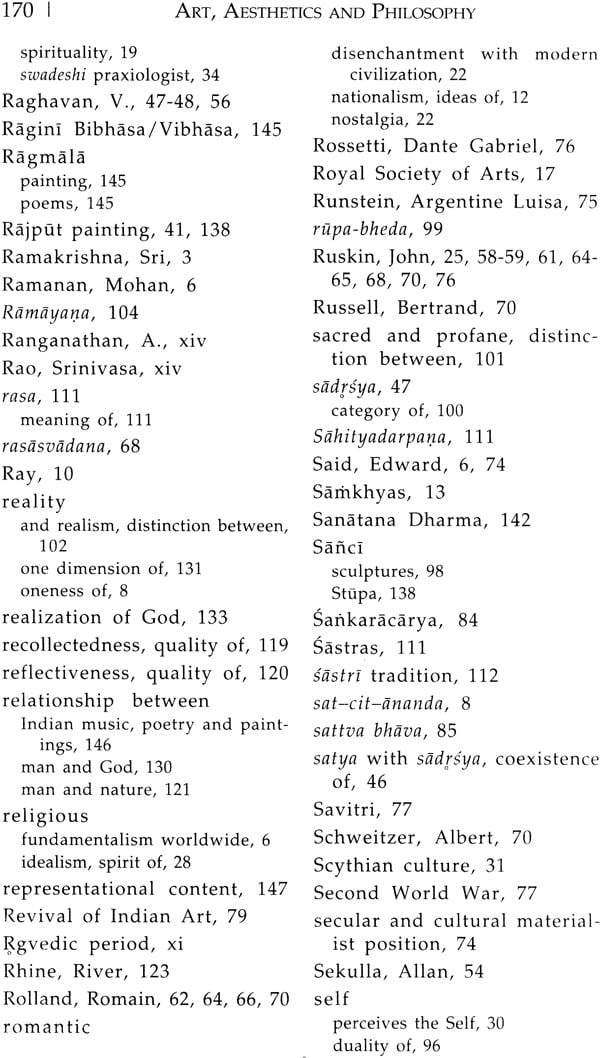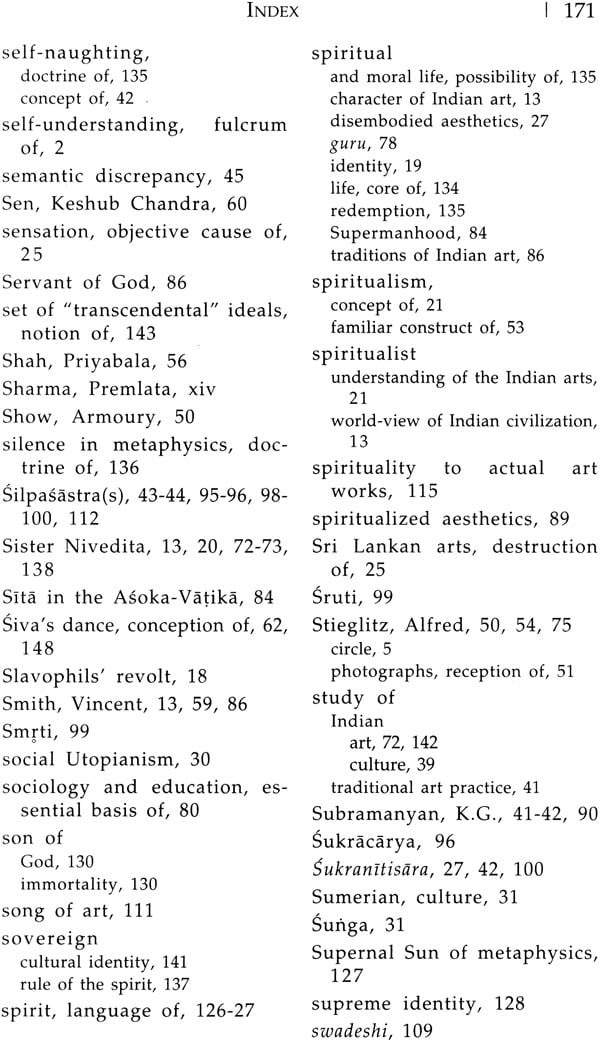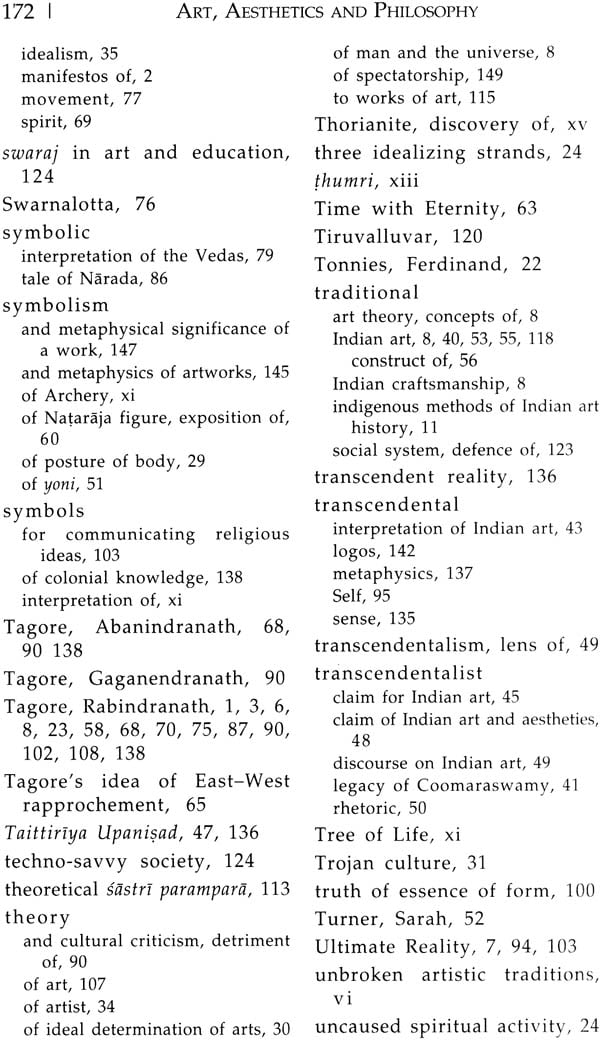
Art, Aesthetics and Philosophy (Reflections on Coomaraswamy)
Book Specification
| Item Code: | NAK706 |
| Author: | S.G. Kulkarni and Kavita Chauhan |
| Publisher: | D. K. Printworld Pvt. Ltd. |
| Language: | English |
| Edition: | 2015 |
| ISBN: | 9788124607640 |
| Pages: | 200 (5 B/W Illustrations) |
| Cover: | Hardcover |
| Other Details | 8.5 inch X 5.5 inch |
| Weight | 450 gm |
Book Description
The savants of the twentieth century have excavated the past to discerningly reveal the present. Swami Vivekananda, Rabindranath Tagore, Sri Aurobindo, Mahatma Gandhi and Ananda Coomaraswamy, among others, interpreted Indian aesthetics, civilization, culture and philosophy unearthing the Indian wisdom against the wrong interpretations and teachings of the Western colonial scholars. This volume, a collection of papers presented at a national seminar on the Philosophy of Ananda Coomaraswamy held in February 2011, approaches Coomaraswamy's philosophy on Indian aesthetics, life and religion from different perspectives. This books brings forth the different facets of Coomaraswamy: as a catalyst in spiritualizing Indian arts; his views on modernism and anti-modernism; his efforts in aesthetizing India; his polemics of de- colonization through art criticism; his aesthetical philosophy; his perception and understanding on art, culture and Indianness; his metaphysics; and his philosophical approach to visuals and materials from the lens of an art historian. It sketches Coomaraswamy's multifaceted persona, enunciating that the crux of modern Indian philosophy is one of vision, rather than building theories.
This book in a nutshell presents the varied reflections on Coomaraswamy's personality as a philosopher, art historian, art curator and his strong positioning against the colonial teachings of Western art historians and philosophers on India's art, civilization and culture, projecting an image of Indianness in every sphere.
S.G. Kulkarni is a Professor of Philosophy at University of Hyderabad, where he has been teaching since 1980. He obtained his doctorate from Indian Institute of Technology, Kanpur. His area of specialization is Philosophy of Science and in particular the Problem of Realism. His areas of interest are Metaphysics and Social and Political Philosophy as well as Modern Indian Thought.
Kavita Chauhan is an Assistant Professor of Philosophy at University of Hyderabad. She obtained her Ph.D from Punjab University, Chandigarh. Her area of specialization is Philosophy of Art and in particular Indian Aesthetic tradition. At present she is pursuing Acharya in Sahitya.
IGNCA understands the arts as comprising of creative and critical literature, written and oral; the visual arts ranging from architecture, sculpture, painting and graphics to general material culture, photography and film; the performing arts of music, dance and theatre in their broadest connotation; and all else in fairs, festivals and lifestyle that has an artistic dimension.
Through its diverse programmes of research, publication, training, creative activities and performances, IGNCA seeks to place the arts within the context of the natural and human environment. The fundamental approach of IGNCA in all its work is both multidisciplinary and interdisciplinary. This work is carried out through five divisions - Kala Nidhi (Library & Information Division); Kalakosa (Research and Publication Division); Janapada Sampada (Division for the Study of Diverse Living Traditions); Kala Darsana (Division for Exhibition and Presentation); and Sutradhara (Division for Administration and Co-ordination). It also has a well-developed Media Unit for audio-visual documentation and film-making as also a Cultural Informatics Lab for the production of interactive multimedia CDs, DVDs and developing a National Digital Data Bank on Culture.
In this organizational milieu, the Kalakosa Division of IGNCA has been bringing out three fundamental series of publications, viz.:
1. Kalatattvakosa - series of Indian key concepts;
2. Kalamulasastra - fundamental texts bearing on the Arts; and
3. Kalasamalocana - a series of analytical and interpretative writings on the Arts.
Out of these, the first is a multi-volume Thesaurus of Indian thought systems and categories of knowledge. These volumes make explicit the multi-disciplinary character of the cognitive reflection that permeates different disciplines and different levels. The six volumes so far published in this series have been enthusiastically received as essential reference material by scholars. The second series is the publication of fundamental texts based on primary materials. These texts range from the earliest discussions on the nature of musical notes to the texts discussing temple plans, town planning, theatre, music and dance. The twenty-six published texts in this series, including some in multiple volumes, throw significant light on the vigorous theoretical traditions of India.
Finally, the third series, under which the present volume is published, comprises publications on analytical and interpretative writings on different facets of the arts and aesthetics. Around sixty works of eminent scholars have already appeared in this series. Some of the major com- positions highlight the unbroken artistic traditions of other parts of Asia as well. Bringing out reprints of the collected works of Ananda K. Coomaraswamy is the most important part of this series. Through his prolific writings, Ananda Coomaraswamy revealed himself as a great art critic, philosopher and historian of our time. His son Rama P. Coomaraswamy gave copyright permission to IGNCA to reprint the works of his father. In fact, way back in 1994, a part of the Ananda Coomaraswamy collection was first acquired by IGNCA through the efforts of Dr. Kapila Vatsyayan, former Member Secretary and Founder Member of the IGNCA Trust. She personally met Rama P. Coomaraswamy in the US and he very generously donated a part of his father's collection. It includes books, photographs, gramophone records, some unpublished papers and slides.
Out of this collection, IGNCA has till date brought out seventeen publications which include reprints of the revised editions of his works, while some are the volumes of his collected papers and letters. A volume of the bibliography of his works also has been published. Details of the published volumes are given in the Preface by Dr Advaitavadini Kaul, Chief Editor, IGNCA, and Coordinator of the Kalasamalocana Series.
In 2008, IGNCA acquired yet another collection of Ananda Coomaraswamy from Francis Nicholas Coomaraswamy. This collection comprises photographs, paintings, about 700 folders containing correspondence, notes and monographs compiled by Ananda Coomaraswamy during his lifetime.
The publication of the present volume may be seen as the fructification of the efforts of IGNCA in presenting the manifold aspects of this multifaceted personality. It is a matter of satisfaction for us that the idea of holding a seminar on Coomaraswamy emerged through the publications of IGNCA. We are happy to publish the proceedings of this seminar as Art, Aesthetics and Philosophy: Reflections on Coomaraswamy which includes eight research papers contributed by eminent scholars in their respective fields. I am grateful to each one of them. My gratitude to Prof. S.G. Kulkarni of the Department of Philosophy, University of Hyderabad for initiating the proposal for organizing the seminar and for bringing it to fruition. Also, I am thankful to him and his colleague Dr. Kavita Chauhan for editing this volume.
Rama P. Coomaraswamy had written a pen sketch of his father for IGNCA. It was published in Vihangama (IGNCA Newsletter) in 2001. We find it appropriate to reproduce it here in this volume.
I am pleased to present this volume to the readers with the hope that it will facilitate and enhance the understanding of the concepts of Indian art and aesthetics.
In the year 2010 the University of Hyderabad had planned a national seminar on the "Philosophy of Ananda Coomaraswamy". They approached IGNCA with a proposal for publishing the proceedings of the seminar. The seminar was scheduled to be held in February 2011 and was to be organized by the Department of Philosophy. IGNCA welcomed the proposal. For IGNCA, the publication of this volume would have added a new perspective to the Coomaraswamy Series that forms a major part of a publication programme known as the Kalasamalocana series. We came to know later through Prof. S.G. Kulkarni of the University of Hyderabad that the very idea of holding the seminar had emerged from the extant publications of IGNCA. In a sense, this is a fulfilment of one of the objectives of IGNCA. It is a matter of satisfaction that the publications of IGNCA have motivated scholars and inspired them to reflect upon and discuss the works of a scholar of substance who gave new perspective to the understanding of Indian art and aesthetics.
The Kalasarnalocana series is one of the elemental publication series of IGNCA. It relates to critical writings on different facets of the arts and aesthetics. While one part of the series concentrates on works of eminent scholars who have dealt with fundamental concepts, identified perennial sources and created bridges of communication by juxtaposing diverse traditions, the other part deals with revisions, and rearranged editions and translations of a select number of eminent authors and their works. The most important part of this programme is bringing out the collected works of Ananda K. Coomaraswamy. IGNCA has till date published seventeen volumes of Ananda Coomaraswamy's writings. These volumes have been reorganized thematically, with the author's authentic revisions, and edited by eminent scholars.
In the Cultural Archives of IGNCA the Ananda Coomaraswamy collection has publications of his own writings which comprise many voluminous books, a very large range of pamphlets, articles, critical reviews, translations and letters published in different countries. A glance at the list of his writings indeed makes one wonder whether one is looking through the catalogue of a library or the works of a single individual. Out of this corpus, the details of the seventeen volumes published by IGNCA till date are summed up below:
Philosophical Writings
1. Time and Eternity (1990): Man's awareness of Time has been articulated in ancient and modern civilizations through cosmologies, metaphysics, philosophy, religion, theory and arts. Coomaraswamy propounds that though we live in Time, our deliverance lies in eternity. All religions make this distinction between what is merely "everlasting" (or "perpetual") and what is eternal.
2. Spiritual Authority and Temporal Power in the Indian Theory of Government (1993, 2013) edited by Keshavaram N. Ienger & Rama P. Coomaraswamy: The Indian theory of government is expounded in this work on the basis of textual sources. The welfare of the community in each case depends upon a succession of obediences and loyalties; that of the subjects to the dual control of king and priest, and that of all to the principle of an eternal law (dharma) as King of Kings.
3. Hinduism and Buddhism (1999) edited by Keshavaram N. Ienger & Rama P. Coomaraswamy: The two essays are authoritative expositions on the teachings of these religions as understood by those who practised them rather than as understood by scholars and comparative religionists who studied and viewed them from without.
4. Perception of the Vedas (2000) edited by Vidya Nivas Mishra: Coomaraswamy published A New Approach to the Vedas, and thereafter he regularly brought out longer and shorter studies of the Vedas and Upanisads. Published in a variety of American, European and Indian journals, these essays have been arranged in this volume in relation to some aspect or the other of Vedic text as one integrated perception.
5. Elements of Buddhist Iconography (2008) edited by Krishna Deva: This study deals with the basic symbols of Buddhist art, viz., the Tree of Life, the Earth-Lotus, the Word-Wheel, the Lotus-Throne and the Fiery Pillar, and shows that these symbols can be traced back beyond their first representation in Buddhist iconography through the aniconic period of the Brahmanical Vedas, even into the Rgvedic period itself, and that they represent a universal Indian symbolism and set of theological concepts.
Writings on Civilizations
6. What is Civilization? (1989): The essays raise fundamental questions, which are both piercing and incisive. In one unbroken sweep, a vast spectrum of Western and Eastern civilizations is covered. Four essays in this volume - "Mind and Myth", "Symbols", "Interpretation of Symbols" and "Symbolism of Archery" - reflect the autumnal ripeness of Coomaraswamy's mind journey as an art historian.
7. Selected Letters of Ananda Coomaraswamy (1988) edited by Alvin Moore Jr. & Rama P. Coomaraswamy: The letters included in this volume, published for the first time, reveal the being of this uncompromising man, who believed in no theories or ideologies, political or philosophical issues. Combining scientific precision with his own sensitivity, Coomaraswamy addresses himself to the disciplines of history, philosophy, religion, arts and crafts. The letters reveal the incredible range of his mind which cuts across civilizations, cultures, languages, arts and crafts, encompassing the whole.
8. A Bibliography of Ananda Kentish Coomaraswamy (2002) compiled and edited by James S. Crouch: This comprehensive and accurate bibliography is an invaluable reference work for anyone concerned with the study of comparative religion, mythology, traditional metaphysics, iconography and symbolism.
Writings on Art and Aesthetics
9. Yaksas: Essays in the Water Cosmology (1993) edited by Paul Schroeder: The origin of the yaksas is examined in the context of Vedic, Brahmanical and Upanisadic literature, along with the non-Aryan and pre-Aryan preoccupation with the concept. Dealing with the interpretation levels of artistic motif, Coomaraswamy delves deeper to unfold the water cosmology.
10. The Transformation of Nature in Art (1995) edited with an Introduction by Kapila Vatsyayan: In this volume, Coomaraswamy attempts to explain the theory behind medieval European and Asian art, especially art in India. The first principle of his theories is that art does not exist for its own sake; it exists as a means to some religious conditions or experience. He supplements the Indian theory with that of the Chinese. The comparison with medieval European art is also extremely illuminating. He shows that both differ radically from post-Renaissance European Art.
One of the significant developments in the post-independent philosophical scene of India is the recognition that the claim that modern Indian philosophy is either not modern or not Indian or not philosophy was a travesty of truth. Our deep engagement with the nineteenth-twentieth-century Indian savants has convinced us that in spite of their organic link with the classical Indian thought, they were sensitive to the intellectual traditions of modernity, responses to which shaped their concerns and positions on some crucial issues, both time-honoured and contextual. Also, though their orientation was intended to be universal their focus was India and, in particular, the colonial condition against which she had begun to struggle in a way that was unique. Further, their thinking was philosophical in the fundamental sense of a culture's self- understanding, on the one hand, and grappling with the civilizational issues raised by the challenges of modernity, on the other, which sought to determine the values guiding our individual life and the organizing principles of our collective life. In view of such a task, "philosophical" in the discursive sense was irrelevant. It is, therefore, natural that the crux of modern Indian philosophy, unlike that of its Western counterpart, was one of weaving visions rather than building theories. This is evident in the works of Vivekananda, Tagore, Aurobindo, Gandhi and Ananda Coomaraswamy, whose thoughts have rendered the very concept of modern Indian philosophy into a distinct theoretical category.
As pointed out above, the primary focus of modern Indian philosophy was India herself, and even here as a civilization, rather than a nation state, potential or actual. The discovery (and invention for the protagonists of imperialism) of India as a civilization was motivated by (1) an endeavour to seek terms of self-understanding and thereby reject India's characterization by the West including the myth of pre-colonial barbarism; and (2) to convince ourselves that the colonial onslaught could not destroy the cultural self of India, though it might have mauled her socio-economic body.
Obviously, such an endeavour begins by directly confronting the issue of tradition vs. modernity, though such an undertaking might end with transcending that dichotomy as one of those dualities the West has used to delegitimize and thus domesticate its Other. In doing so, the modern Indian philosophers articulated their idea of tradition that speaks volumes about their creative imagination. Geeta Kapur very ably brings this out when she says:
What in India we call tradition today was put in the fray by 19th-century nationalists. The manifestos of Swadeshi (political and cultural self-reliance)... produced in conjunction with the ideal tradition, a kind of aesthetic which is at once didactic and contemplative. This is best exemplified by A.K. Coomaraswamy. -1990: 48
Since tradition so construed is another name for lndianness, it was the fulcrum of self-understanding and hence of resistance. The attempt to dive deep into the collective memory of the people and to affirm the value of the extant modes of life was an effort to win back a civilizational poise set at naught by the forces of colonialism. To quote Geeta Kapur again:
If the savants of the [20th century], among them Coomaraswamy, have excavated the past to provide the present (in their opinion errant and impoverished) century with perennial life-symbols the exercise has rather special significance when this is contextualized within an anti-imperialist struggle.
The national culture construed on the lines of reconfigured tradition was not anchored in the transcendental notions figuring in the Indian metaphysical tradition, though such notions do figure in the articulation of the idea of national culture. We may say these notions were connected to the concrete lives of the people. The Upanisadic message was read by Tagore in the art of the folk such as the songs of baul musicians. Vedantic ideas were connected to ordinary people's religious ethos by Vivekananda, thanks to his association with Sri Ramakrishna. Gandhi related truth with the ethos of the productive life of peasants and artisans:
With Coomaraswamy tradition, besides its metaphysical status, is the code derived from and applied to actual/ideal iconographic forms. -1990: 50
Hence, there was no need to bring tradition to life as it was alive and in the case of Coomaraswamy, it found living expression in the canonical aesthetic of craftsmen. It was this recognition of the ways tradition finds living expression that goes against their characterization as conservative. Further, modernist dichotomies, such as tradition and modernity and trichotomies, whether conservative, liberal and radical, may help us to understand an intellectual/cultural phenomenon only up to a point beyond which it is detrimental to its authentic understanding, in particular, grasping how a creative thinker defies formulae by the very dynamism of his thinking. More importantly, conservativism merely rejects modernity, it does not work out its critique which points to an alternative vision, and this is precisely how modern Indian thinkers succeeded. Their critique of modernity was at once profound and concrete. Modernity was fundamentality construed in terms of the industrial civilization and the attack on it was cognitive, ethical and aesthetic. That is, the critique portrayed modernity as false consciousness, immoral and ugly. Particularly important in this connection is the vision of a "post- industrial society" - words coined by Coomaraswamy as acknowledged by Arthur J. Penty who used this expression in connection with the concept of Guild Socialism - a concept which found its first expression in the thoughts of those whom Karl Marx called "Patriarchs of Socialism" (cf. Brantlinger 1986: 485). Coomaraswamy contraposes what he called "inspired tradition" that emanates from highest religious consciousness with modern civilization. A society based on the former is a cooperative workshop whose production is geared towards use and not profit. Industrial society, the icon of modern civilizations, replaces needs that can be fulfilled by wants which keep artificially multiplying by transforming human needs into market demands.
We have touched only a couple of issues which Coomaraswamy addresses with matchless intensity and conviction. There are many other issues especially those pertaining to art and aesthetics on which Coomaraswamy took positions. The papers in this anthology critically engage with his positions on these issues. We summarize these papers, as far as possible, in the words of the authors themselves.
Sharad Deshpande in his "Ananda Coomaraswamy and Spiritualization of Indian Arts" begins by asking what happens when two civilizations meet one another under colonial conditions and what makes one civilization interpret the other the way it does? He argues that these questions presuppose a much wider civilizational context of the reception of ideas, values and beliefs on both sides of reception. What makes Ananda Coomaraswamy one of the most central figures in the modern Indian art history is, for Deshpande, his awareness of this larger civilizational context. Therefore, to situate Coomaraswamy in the context of the historical unfolding of the civilizational encounter between India and Europe would be a pre-condition of any meaningful reading of Coomaraswamy. After spelling out some of the details of this encounter Deshpande traces how the construction of an idealistic, spiritualist world-view of Indian civilization and its aesthetic traditions emerged in the writings of E.B. Havell, and following him Ananda Coomaraswamy. According to Deshpande we need to have a theoretical framework to see the interrelatedness of various concepts and doctrines through which the spiritual or the idealistic character of Indian art was inscribed by the colonial scholars of Indian art history.
Parul Dave Mukherji in her paper "The Two Faces of Ananda Coomaraswamy: Discourses on Modernism and Anti- Modernism" focuses on the significance of a reassessment of Coomaraswamy's legacy in our increasingly globalized world. Looking back at the twentieth-century cultural politics, Coomaraswamy emerges as a heroic figure who singlehandedly brought about a profound transformation in taste, sensibility and categories of seeing art. At a time when Asian art was still a beleaguered entity and Indian art did not even feature as culturally significant, Coomaraswamy became a Messiah of the East, a saviour of Indian and Asian art and a champion of an alternative, non-Eurocentric aesthetic. From a post-colonial perspective, it is easy to reclaim Coomaraswamy as an agent of decolonization whose interpretation of Indian philosophy and aesthetics enabled a positive recognition of cultural difference and a radical critique of modernization. However, recently, there has begun a reassessment of Coomaraswamy's legacy in the West that focuses on him as an ardent exponent of modernism. From his role as a defender of Eastern art, today Coomaraswamy's work assumes significance in the history of modernism itself. His close association with the Stieglitz circle, the Euro-American avant-garde and his early acceptance of photography as worthy of a museum collection align him squarely with the modernists. How do these two conflicting constructs of the Coomaraswamian legacy relate to our contemporaneity that is no less ridden with contradictions between universalism and cultural difference?
| Foreword | v | |
| Preface | ix | |
| Ananda Coomaraswamy: A Pen Sketch | xvii | |
| Acknowledgement | xxv | |
| Contributors | xxvi | |
| Introduction | 1 | |
| 1 | Ananda Coomaraswamy and the Spiritual Reading of Indian Arts | 10 |
| 2 | The Two Faces of Ananda Comaraswamy: Discourses on Modernism and Anti-Modernism | 39 |
| 3 | Aestheticizing the Nation: An Essay on Ananda Coomaraswamy | 58 |
| 4 | Polemics of Decolonization: The Art Criticism of Sri Aurobindo and Ananda Comaraswamy | 72 |
| 5 | Towards an Understanding of the Aesthetical Philosophy of Coomaraswamy | 92 |
| 6 | Ananda Coomaraswamy on Art, Culture and Indianess | 107 |
| 7 | Coomaraswamy as a Metaphysician | 125 |
| 8 | The Visual and the Material in Coomaraswamy's Art History | 138 |
| Index | 155 |
